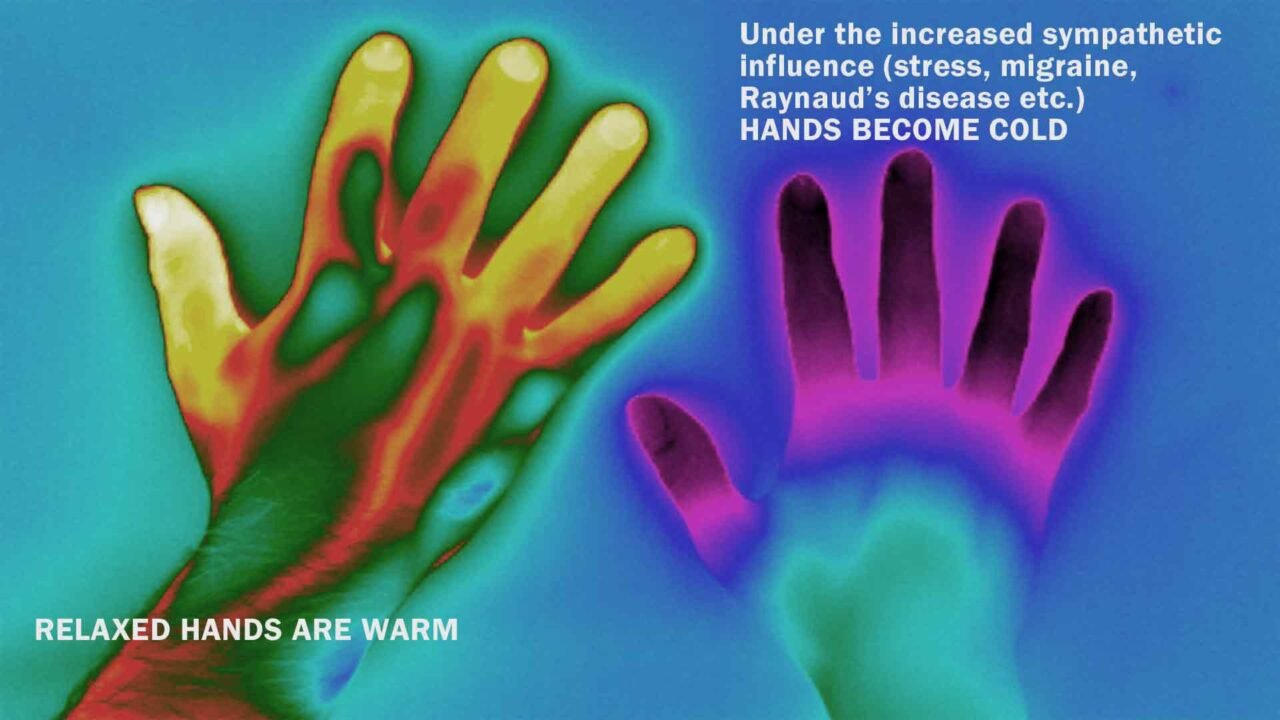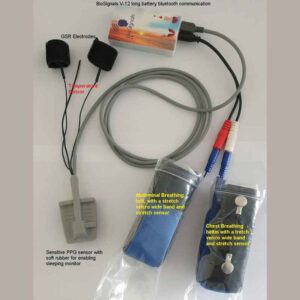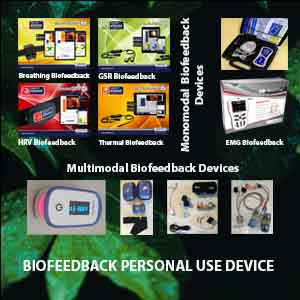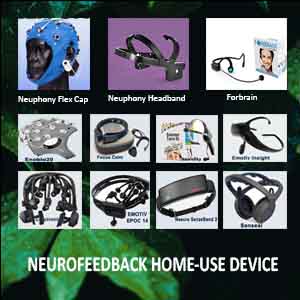Temperature Biofeedback Improves Health
Temperature biofeedback is a powerful tool for managing health and enhancing performance. Specifically, skin temperature biofeedback focuses on monitoring changes in the skin’s temperature, providing valuable insights into the body’s physiological responses. This type of biofeedback that measures temperature is called temperature biofeedback, which includes thermal biofeedback techniques. These methods can help individuals learn to control their body temperature in response to stress, anxiety, and other factors. By harnessing this technique, you can gain greater awareness of your body’s signals, improving relaxation, stress reduction, and overall well-being.
Table of Contents
Toggle- Temperature Biofeedback Improves Health
How Biofeedback Uses Skin Temperature to Boost Relaxation Fast
The temperature at the surface of the skin changes according to blood circulation through body tissue. Small blood vessels, or arterioles, cross through body tissue and are surrounded by smooth muscle fibers. The sympathetic nervous system controls these muscle fibers.
In a state of increased exertion, excitement, and stress, these muscle fibers contract, causing stenosis of the vasculature. This reduces blood circulation through the tissue, reducing skin temperature. In contrast, the musculature is also bound to relax in a state of relaxation, causing the vasculature to expand. Hence, the skin temperature rises.
Mental stress often lowers blood flow to the hands, decreasing skin temperature. This happens because the sympathetic nervous system becomes more active. Evolutionary roots explain this reaction. Originally, tension and anxiety prepared the body for flight or attack. As a result, the body redirects blood to essential working muscles, like those in the upper arms, thighs, and torso, by narrowing blood vessels in the hands, feet, and forearms.
For example, think of a speech you gave in front of an audience or a job interview panel. Can you remember having cold (and sweaty) hands if you were anxious?
This physiological stress reaction can be useless or even harmful in many contexts in modern society (e.g., mental exertion, worries, psychosocial stress, and anxiety disorder). Conscious control of physiological stress can help you react more relaxed and efficiently in many situations. Biofeedback is an established way to learn this kind of control!
SKIN TEMPERATURE BIOFEEDBACK TRAINING
Thermal biofeedback, also known as psychophysiological feedback, is a type of treatment that uses a person’s body temperature to assess that person’s physical state.
Over time, a person can learn to control their body temperature by monitoring real-time changes in their thermal state. This practice helps them gain control over specific physical issues.
With biofeedback training, individuals can aim to raise their skin temperature to reduce stress and alleviate its physical symptoms.
Biofeedback with skin temperature is mainly applied in relaxation exercises. It’s easy to handle and learn. Experience with this technique shows a high success rate and improvement in subjective well-being. In the therapeutic field, skin temperature biofeedback is often and effectively used in the management of migraine and chronic pain, high blood pressure, insomnia, pain, stress, digestive disorders, and many, many other ailments. If you suffer from a severe disorder or medical condition, always consult a professional physician or therapist, and do not attempt to treat yourself.
Biofeedback training does not require the use of drugs or surgery to alter the body but teaches the body to alter itself. Once a person masters a biofeedback skill, they typically no longer need training equipment. However, they may use feedback occasionally to fine-tune or confirm their ability to apply the skill effectively.
HOW TEMPERATURE BIOFEEDBACK WORKS
Hand-Warming Biofeedback Training: How Temperature Sensors Help Track Stress Levels
A straightforward and effective biofeedback method is hand-warming training. It works with the temperature sensor attached to a finger or between the thumb and index fingers. The temperature readout appears on a digital screen, allowing the patient to track their body temperature minute by minute. A drop in hand temperature indicates how tense a person is. This is because, during stress, the body will divert blood from the body’s surface area to the muscles and organs, allowing us to better respond to a nearby threat. This reaction is known as the “fight or flight” response. Conversely, when our surface temperature is high, it usually indicates that we are relaxed or sleepy.
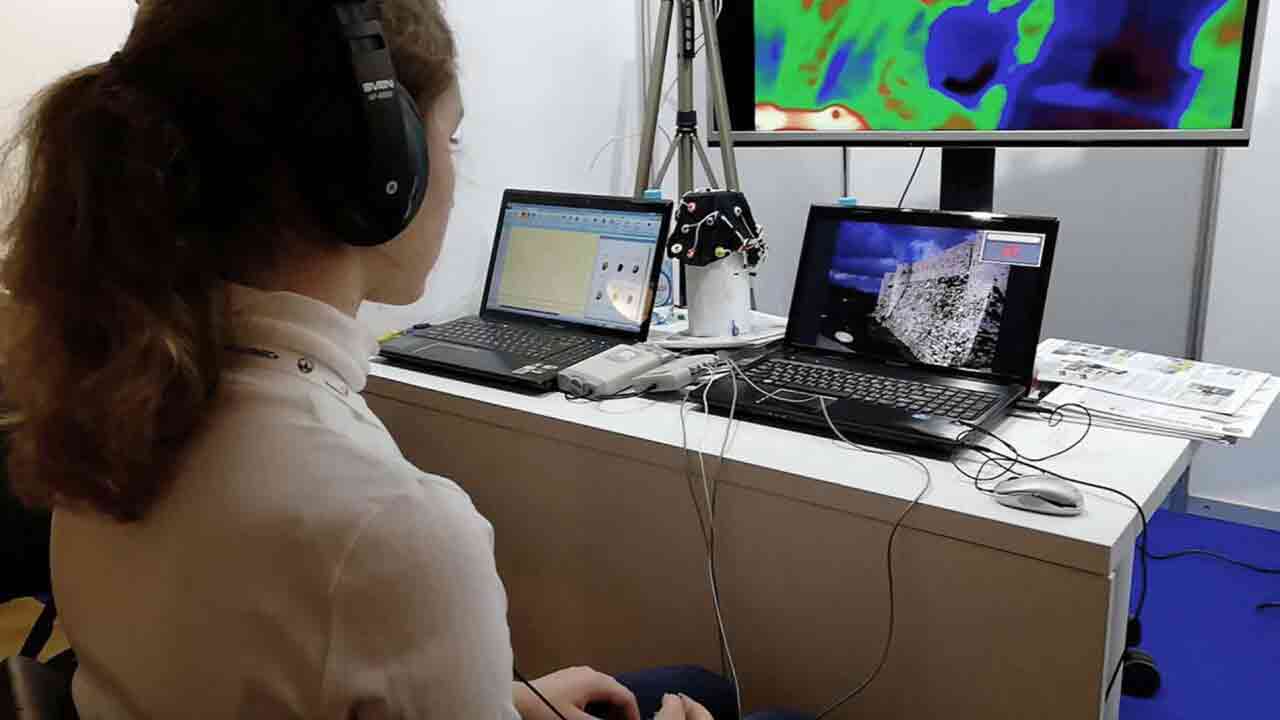
Mastering Thermal Biofeedback at Home: Tips for Effective Hand Temperature Training
Through direct feedback, you will learn to intentionally raise the temperature of your fingers, thus increasing perfusion in your hands.
When measuring hand temperature, consider the following factors to ensure the best feedback on body temperature. First, always take readings in a neutral-temperature room that is neither hot nor cold (20-22°C / 68-72°F) and free from distractions like phones.
Next, always use the same finger for temperature records. Ensure that the tape securing the temperature sensors is not too tight, as this could inhibit circulation. Additionally, avoid areas with fans, air conditioners, heaters, drafts, or breezes. Finally, avoid contact with warm or cold objects, such as drinks or outdoor exposure.
Thermal biofeedback can be performed at home. A person would only need the proper equipment and a bit of patience and imagination, in this case, imagination, to visualize conditions to help control body temperature. For example, someone could use mental visualization to imagine sitting in a cold room to help drop their temperature or vice versa. Children tend to be more successful in practicing thermal biofeedback at home because they are naturally more imaginative than adults.
HOW DO WE REGULATE OUR HAND TEMPERATURE AND REDUCE STRESS?
Methods for Raising Hand Temperature: Deep Breathing, Muscle Tensing, and Visualization Techniques
There are many different ways to increase hand temperature. It is suggested that a person try them all and find the best method for him/her. The basic idea behind these methods is to focus consciousness on the experience of being profoundly relaxed.
One of the most common ways to relax is deep breathing, which has an ancient therapeutic history. It is accomplished by taking a deep diaphragmatic breath and then exhaling for a longer count than the inhalation.
Muscle tensing is accomplished through sessions of tensing muscles and then wholly relaxing them. It is believed that the relief you experience after tensing your muscles is an analogy of the conscious relaxation process you are trying to learn.
In the imaginary method, relaxation occurs when the person envisions a peaceful, warm, and calm place, such as lying on a beautiful imaginary beach. It is helpful if the person imagines the warmth and imagines themselves there.
Relaxation Techniques to Increase Hand Temperature: Music, Autogenic Phrases, and Open Focus
It is well known that music impacts relaxation. Many people find it relatively easy to increase their hand temperature by sitting in a comfortable chair and listening to appropriate soft music.
Positive, present-tense statements are said to oneself in the autogenic phrase method. Examples would be: I feel pretty relaxed. My hands are beginning to feel warm. My muscles are all loose and comfortable. I can feel the blood running into my hands. My hands feel heavy and warm. This is a prevalent method and works for most people.
On open focus, the training person tries to imagine an interior portion of space in the body. Examples might be: Can you imagine the space between your eyes? Can you imagine that your hands and fingers are filled with space? Each statement is made, and then the pause briefly concentrates on the specific area for about 10 seconds.
BENEFITS OF THERMAL BIOFEEDBACK
When used consistently and under proper conditions, thermal biofeedback can remedy the effects of stress and tension in the body. It is particularly beneficial for reducing migraines in headache sufferers. In fact, studies have shown that thermal biofeedback can be more successful in treating migraines when used in combination with traditional migraine medications.
It is also beneficial in treating Raynaud’s Syndrome or “white finger,” which causes discoloration in a person’s fingers or toes. This is caused by blood vessels constricting and slowing blood flow to the fingers or other body areas. It can be harrowing for a person who develops it, and the effects of stress or cold are usually the causes of it. In this case, thermal therapy is an ideal treatment for such a condition, especially for someone unwilling to undertake traditional medical treatment or take prescription medications.
Besides helping to alleviate various medical issues, thermal biofeedback can also improve one’s mental state and overall mood. By improving one’s mood, a person will be able to perform at higher levels of concentration and, subsequently, higher levels of success. This can be applied to job performance, athletics, or even just day-to-day activities.
Overall, thermal biofeedback is an effective and fairly inexpensive therapy. It can be used simply and within the comfort of one’s own home. With just a little guidance and thorough practice, anyone can use the technique to improve their physical state and well-being.
BIOFEEDBACK TRAINING STAGES
Hand-warming training aims to show people their skin temperature and help them gain direct control over the blood circulation in their outer limbs. Biofeedback training consists of four stages. For the first training, schedule about 60 to 90 minutes of free time to conduct the training undisturbed and at a stretch.
To train successfully, find a quiet room with a temperature of 20-22°C / 68-72 °F and where there are no phones or sources of distraction. Make sure the room has convenient seating and that you are wearing comfortable clothing. Skin temperature also depends on ambient temperature, so you should try to perform each training session under similar conditions.
You should acclimate to the ambient temperature for at least five minutes before starting the training. This allows your body to relax and remain steady as you begin. This phase of acclimatization can already raise your hand temperature by several degrees.
PRACTICAL GUIDE FOR TEMPERATURE BIOFEEDBACK TRAINING
First Stage
Observing and determining the initial status is necessary in the first stage of the thermal biofeedback.
Compared with other biofeedback techniques, reliable success requires 6-10 sessions. Each session should be limited to about 30 minutes to keep focused throughout. You should shorten your sessions and practice more often if you tire while training.
In your first session, take ten minutes and try to relax. How you do this is up to your personal preferences and possibilities.
At the beginning of each session, recording the baseline state for 2-3 minutes is necessary, letting the sensor temperature adapt to the finger. Sit upright and comfortable, and DO NOT WATCH THE TEMPERATURE in the app; let the device measure! The temperature should reach a constant level for the actual training to begin.
When you are neither deeply relaxed nor stressed in a room of normal temperature, the starting hand temperature will be in the mild or high 26-27°C / 80°F. Finger temperature of 26-27°C / 80°F is cool, 23-24°C / 75°F is cold and 21°C / 70°F or below is very cold; 32°C / 90°F is warm.
Setting and Achieving Hand Temperature Goals: Monitoring Progress in Relaxation Training
The training goal is 34-35°C / 95-96° F for 10 minutes.
If your hands are cold, the temperature may increase very slowly. Only after several minutes of training will the temperature rise rapidly if they are in the low-mid 26-27°C / 80°F.
If your hands are in the low-mid 32°C / 90°F, the temperature may increase slowly, with only a few degrees of increase, but at that level, a few degrees is a significant change.
Training measures whether relaxation already leads to a higher temperature in your finger.
AFTER RELAXING, LOOK at the measured values and see whether you have already caused an increase in temperature by relaxing. Were there sections of rising values? Did the level remain constant? Or does the curve drop slowly during the measurement? How do you rate your ability to relax during the measurement?
You may already be able to determine a relationship between the curve and the tension or relaxation you are feeling. Regardless of whether you’ve succeeded, observe the measured values and test whether you can influence the temperature at will. After that, the first training phase is over.
Of course, the day also plays a role here; it may make a difference whether you are measuring after a stressful working day (or even at work) or at the end of a relaxing weekend. Before taking another measurement, pay attention to the daily activities during which you are more likely to have hot or cold hands. These observations may be helpful later in further sessions.
Second Stage
Temperature feedback is performed in the Second stage of thermal biofeedback training.
The second stage consists of multiple sessions. These sessions should always follow the following scheme: Start every session with a 2 to 3-minute baseline measurement WITHOUT watching the values to reach a steady state.
After that, you can train conscious relaxation using the feedback signal. WATCH the temperature values while relaxing and try to find ways to raise them. It can be helpful to imagine yourself lying in the sun, relaxing in a sauna, or putting your hands into warm water. You can also work with autosuggestion techniques, telling yourself sentences like, “My left-hand feels warm…it feels even warmer now…” Feel free to experiment.
As with every activity, regular practice is the key to success. You should be able to raise your skin temperature by several degrees unless your baseline is already at 33-34°C / 91-93°F. The colder your hands are in the first place, the more potential you have to raise their temperature. In general, your hands can reach a temperature of more than 36°C / 97°F, the temperature of your body’s core.
Third Stage
The learned relaxation skills should be used without feedback in the third stage.
In the third stage, you can check if a state of deepened relaxation and the corresponding rise in skin temperature can already be achieved without feedback.
After measuring the baseline, you should alternate between watching and not watching the feedback (two minutes each way). The longer and more often you can keep the temperature up without the input, the better your self-control has already become. When you are not using the feedback, don’t look at the values in the app.
In the third stage, multiple sessions are performed. You have completed this stage when you can keep your skin temperature up for a prolonged time, mainly without feedback.
For the best comparability of training results, training sessions should always be performed under identical conditions (same time of day, electrode position, and type) and of approximately similar duration.
Fourth Stage
In the fourth stage, the provocation (relaxation and stress stimulus) should be used during a biofeedback session.
In the final fourth stage, you should check if you have acquired improved stress resilience. Start a session with the baseline as usual, and then keep your skin temperature elevated (well above 30°C / 86°F) for a couple of minutes.
After that, try to bring yourself into a strenuous situation, recalling previously memorized everyday situations in which you had cold hands or situations that made you tense and angry. You can also move to a stressful environment or ask another person to exert a stressful stimulus upon you. Keep the stress situation short, and do not overload your coping ability. Under stress, observe if the temperature drops, and try to keep the temperature at a high level to avoid temperature drops.
Always change phases of stress and targeted relaxation.
Suppose you can sustain elevated skin temperature levels during strenuous situations, ideally above your maximum in the first stage. In that case, you have learned to remain relaxed and calm even in difficult and stressful situations.
You have fully reached the goal of hand-warming training!
FAQs: Temperature Biofeedback Improves Health
Low hand or finger temperature typically indicates stress or dominance of the sympathetic nervous system. When you’re calm, the peripheral blood vessels dilate, increasing blood flow and temperature. Training to raise skin temperature helps reduce stress and improve autonomic balance.
Temperature biofeedback involves training your body to increase peripheral (usually fingertip) skin temperature. Sensors measure temperature in real-time, providing visual or auditory feedback to help you learn how to influence your autonomic nervous system and promote relaxation.
This method helps relieve stress, anxiety, headaches, insomnia, Raynaud’s disease, and chronic pain. It also improves blood flow, emotional regulation, and resilience to stress.
Yes. It’s widely used as a non-drug treatment for migraines and tension headaches. Warming the hands leads to vasodilation and relaxation, which often reduces headache frequency and intensity.
By focusing on slow breathing and warming the fingers, you activate the parasympathetic (relaxation) response. This calms the nervous system and reduces anxiety symptoms naturally and without medication.
Temperature Biofeedback Home-use Device
The BioSignals 5 Biofeedback Sensors Device stands out by combining temperature biofeedback with three other powerful modalities: heart rate variability (HRV), electrodermal skin activity (GSR), and breathing biofeedback. This multimodal approach significantly enhances training effectiveness by addressing multiple physiological systems simultaneously. By monitoring and improving stress-related responses across these interconnected systems, users can achieve quicker, more noticeable results in stress reduction, emotional regulation, and overall health improvement. The synergy of these modalities makes the BioSignals device an ideal solution for those seeking faster progress and deeper insight into their mind-body connection.

